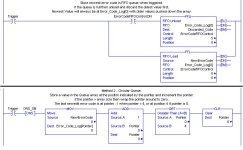Hi Peoples,
Was wondering if anyone could help me out...
I have created a 'Error log' array with a length of 5 and want it to store my minor and major fault codes in. Once the first fault code goes in I don't want it to be over-written by the next fault code. So basically first fault code will go into 'Error_Log[0]' then the next 'Error_Log[1]' and so on up to Error_Log[4]. A bit like a bit shift....
I've got the GSV minor and major fault record instructions (one for each) Dest 'Major_Fault_Reg' DINT[11] & 'Minor_Fault_Reg' DINT[11].
I've then got a MOV 'Major_Fault_Reg[2]' (source) to 'Error_Log[0]' (dest), At the moment it's just over writing.
Not sure how to go about this, any ideas or leads will be greatly appreciated!
Thanks in advance
Was wondering if anyone could help me out...
I have created a 'Error log' array with a length of 5 and want it to store my minor and major fault codes in. Once the first fault code goes in I don't want it to be over-written by the next fault code. So basically first fault code will go into 'Error_Log[0]' then the next 'Error_Log[1]' and so on up to Error_Log[4]. A bit like a bit shift....
I've got the GSV minor and major fault record instructions (one for each) Dest 'Major_Fault_Reg' DINT[11] & 'Minor_Fault_Reg' DINT[11].
I've then got a MOV 'Major_Fault_Reg[2]' (source) to 'Error_Log[0]' (dest), At the moment it's just over writing.
Not sure how to go about this, any ideas or leads will be greatly appreciated!
Thanks in advance





